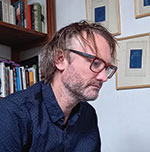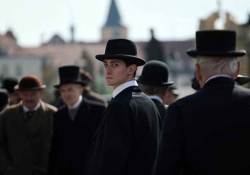Regarding Swedish
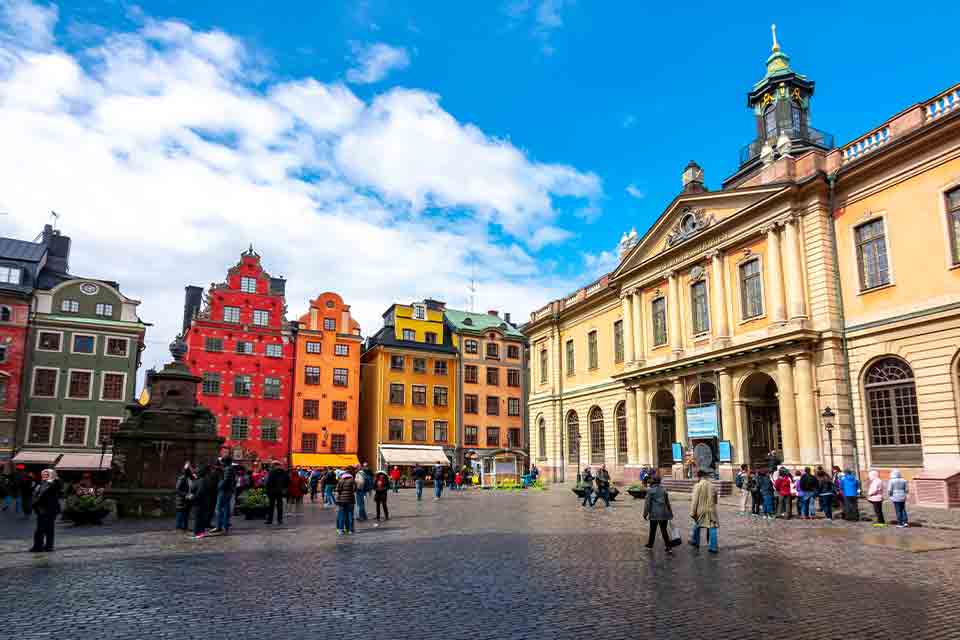
An Argentine in Stockholm marvels over the Swedish language and Sweden’s culture.
The first time I ever heard Swedish spoken was on a visit to Stockholm. I was in a large square in the city center and a man was standing on a bench, giving a speech through a megaphone. I couldn’t make out a single word; the sounds and contours of his voice were completely alien to me. I thought it sounded rhythmic and musical, like Italian spoken backward. It was summer, the light fell in translucent shafts, and people on the street were smiling. How wonderful, I thought, to be surrounded by humans and not understand a word.
On that brief visit I memorized the station announcements on the subway: “Nästa: Mariatorget. Nästa: Slussen. Nästa: Gamla Stan.” The voice bounced around in my head for a long time. I repeated it to myself every time I thought of Sweden. Nästa: Mariatorget. Nästa: Slussen. Nästa: Gamla Stan.
Six years later, I moved to Stockholm. The first time I got onto the subway, I eagerly waited for us to get to Mariatorget, Slussen, and Gamla Stan so as to savor the familiar cadence and music of the announcer’s voice. But what I heard was surprising; it was more or less the same, but something had changed. Or rather the voice was the same, but I remembered it sounding different. This change often happens with photographs—they confound our memories of the past. But until that moment, I hadn’t realized that sounds were susceptible to the same kind of distortion in our organic memory banks.
When I began to learn Swedish and was hearing it spoken every day, I found that my Spanish-speaking ears were deaf to certain things. As the days and months went by, my hearing started to become more attuned and perceived the unsuspected spectrum of sonic subtleties my own vocal instrument was incapable of re-creating. I had misremembered the loudspeaker announcements on the subway because I had been oblivious to Swedish vowel sounds. If you’ve never seen the color purple and suddenly came across it one day, would you later remember it as blue?
Before learning Swedish, I used to think that the biggest difficulty presented by the language (or any language) was the consonants. How wrong I was! Consonants are a workout for your mouth. They’re produced by physical flicks and smacks of the tongue, lips, and teeth. Producing said sounds is like laying the bricks of a language, and with patience and practice one can get to a satisfactory level. But the vowels . . . oh, the vowels! They’re elusive. When we mimic the sound of a foreign consonant, we intuitively employ our organic tools: the tongue, the palate, the teeth, and the lips. The tongue, hard laborer that it is, rushes around from one side of the mouth to the other, hammering away, confident in its solid world. Vowels, on the other hand, are a different matter entirely. If the consonants are the bricks of a house, the vowels are the empty spaces, the air that blows in through the windows and circulates through the building. How do you sculpt air?
The tongue, hard laborer that it is, rushes around from one side of the mouth to the other, hammering away, confident in its solid world.
To mimic a vowel, you can’t draw on your prior experience or observation of someone else’s face. The only information you get about producing a vowel is what you see from the outside: the lips and the facial muscles. There’s also the auditory information—valuable data, but incomplete—which offers a hint as to what is going on in there, out of sight. Listening to vowels is like guessing at the layout of rooms inside a house from the outside. Swedes enjoy a great wealth of vowels, perhaps because they’re from a wealthy country with plenty of open space, a country of fresh air. Swedish has sounds that don’t exist in other languages, such as the ɧ, which sounds like wind rushing along the sides of a tunnel. There’s also the exotic, compact vowel ʉ, which requires that you cup your tongue, like two hands scooping up water. These two sounds combine for the most beautiful and strange word in Swedish, the number seven: sju, a very short word that stops time because it’s brought to life by simultaneous inhalation and exhalation. The final flourish of the word sju on the lips is a tiny slash through the air.
There is a mysterious connection between the throat of the speaker and the ear of the listener. When I hear Swedish women speak and try to copy them, it’s my vocal cords, lips, and tongue that have to do the conceptual and imitative work. Swedish women have otherworldly voices, deep and sensual, and they can open and close their glottis at will to produce heavy and taut vowels, or expansive and roomy ones, as required. I heard that many young women today imitate the upper-class accent found on Lidingö Island to the north of Stockholm, where the vowels are dark and everyone speaks as though their tongues are too big for the air to get in. Apparently it’s a recent phenomenon. In Stockholm, I watched several films by Ingmar Bergman, and no one spoke in the cavernous voices one hears in the stores in the center—voices wrapped in expensive, shapeless coats, under cashmere hats.
Swedes inhale brusquely to show that they’re listening or to indicate agreement, in a manner similar to the way Argentinians express amazement. They do so at regular intervals as a sign of politeness. The first time I had a long conversation with a Swedish woman, I thought she was suffering from asthma. In the north of the country, a sparsely populated region where there’s lots of space between people, this is taken to an extreme: instead of saying “yes” or nodding, they make a sound not dissimilar to sucking on a metal straw.
The space one places between bodies is reflected in the language, and Swedes respect people’s turn to speak much more than Argentines. They wait for the other to finish before beginning their response. Sometimes the only answer is a slow “Ja-ha!” A perfectly normal family dinner might include long periods of silence. On the beaches in summer, you can hear the sound of the water, the birds, the wind through the trees, and children playing. It wouldn’t occur to anyone to bring along a speaker to play music in public. It’s obvious that silence doesn’t make them uncomfortable; they enjoy being in the open air. Maybe that’s why they seem cold to us. They’re used to the distance between bodies and don’t try to fill every space with voices or gestures or music or food. Rather than cold, I’d say they were cool—the very essence of cool, it’s as though the word were invented for them. Cool—like cold, warm, and hot—is a measure of the physical world, temperature, but also a quality from the spiritual world: temperament. No one would dispute that Swedes are a long way from being passionate or excitable. But the coldness we see in people who are different from us is just a question of temperament. It bears no relationship to feelings (or, of course, to one’s actual body temperature).
Some words have a primary meaning linked to space and a secondary, metaphorical one. I first noticed this a long time ago, when I began teaching Spanish as a foreign language. But in recent years, immersed in an unfamiliar language, I’ve been struck by the phenomenon far more regularly; I’ve started seeing it everywhere. I’ve seen the duality of language in the smallest of words: prepositions. Under, for example. Under the table, under the bridge, or under the rain all express the spatial idea of being underneath something, to be below. Under pressure, under a spell, under the influence of someone or something all express the metaphorical idea of being in a position of lesser importance, will, or power. Or against. Against the wall, against the wind, or against the ropes, are all spatial terms. But we also say against their will, against cancer, or against the enemy, in which the space is illusory. Language is full of these phrases. Which of the two meanings came first? You would assume that the spatial meaning always precedes the rest. Even time is only a means of understanding space. Perhaps the concept arose so early in human language that its origins are now lost to us.
The rhythm and pronunciation of a phrase are very important in Swedish. If you get the rhythm right, they’ll think you’re speaking well, even if your grammar is a mess. I’ve pondered an experiment: teaching a language without ever using the written word, teaching and learning orally, the way children do. Writing is, after all, a consequence, a secondary product. The sju I wrote above is infinitely inferior to the spoken version uttered by a living, breathing person.
Swedish has a beautiful word for a period of the day that isn’t differentiated in Spanish: kväll, the equivalent of evening in English, sera in Italian, soir in French, and vespre in Catalan. It’s a little like atardecer, but atardecer only refers to the brief moment when the sun goes down. No one says, “See you this sundown” or “Good sundown.” Spanish also has velada, but it’s not used much and certainly not as a greeting. Is Spanish the only Romance language to have lost the concept? Or maybe it lives on, as in the Portuguese, as a diminutive evoking the fading light: tardecita, nochecita.
In Swedish, morning is morgon, and night is natt. As is true of all words, their use is defined by convention. In winter, night begins at four in the afternoon, but no one would dream of saying “four at night.” The same is true of summer, when the sun comes up at three in the morning. Whatever the sky is doing, people will still regard three a.m. as nighttime.

In summer, Swedish sunsets last for hours and hours. Endless evenings of golden, translucent light shining in your eyes. The light never shines down from above, because the sun’s arc never goes through the zenith. The long shadows and ochre light burnish the people sitting in the grass under the gleaming trees.
There’s a tree everyone loves, because it’s a sign of summer. It’s called the asp, or aspen, and is tall with rounded, coinlike leaves that make a crisp, calming rustling sound. Seen from afar on a windy day, aspens look like an enormous green bonfire.
If a group of friends goes for a picnic under an asp by a lake on a summer kväll and one of them undresses on the dock and jumps into the water for a swim, their body outlined against the setting sun will look as though it were cast in bronze, and the water around them will resemble liquid metal.
A South American in Stockholm will always have the following problem: in winter they’ll miss the sun with all their might. But in summer they’ll want to see the stars, which, either because of the latitude or urban lighting, are sparse in the city’s night sky.
Like other Scandinavian languages, Swedish has two words to refer to daytime where most languages, Spanish included, only have one. Dag is the day of daylight, when the sun shines—and over the centuries this word has evolved to mean “the time of day when you work”—and dygn, which is the span of time the earth takes to spin on its axis, twenty-four hours. The kiosks on Pressbyrån are open 24/7: dygnet runt. Here it’s perfectly acceptable to buy a hot dog and eat it in the street, but I’ve never seen anyone eating on public transport other than gum or a discreet cracker, the kind that doesn’t make crumbs. Neither have I seen anyone eating a satsuma or french fries. People don’t eat on trains, subways, or buses. They travel sitting down, staring into space or at their phone screen, avoiding eye contact. Not many people read physical books. No one strikes up a conversation with a stranger and only very rarely do they say excuse me. They simply pass by, contorting themselves to avoid physical contact as far as possible. There’s plenty of space around people on public transport, and people get on and off the conveyances with calm and poise, as though they were entering a theater. If someone bumps into someone else, they’ll most likely smile and say, “Oi.”
Swedes are spread out sparsely in their very large country. They’re not used to crowds and so tend to be clumsy in urban centers. They don’t know how to walk in a crowd. They always stand on the right side of the escalator but don’t know how to walk on a busy street; they hesitate and bump into one another like headless chickens. They need plenty of fresh air around them to be able to maneuver in the city, perhaps a lingering effect of the country’s agricultural past, centuries and centuries of plentiful personal space. Most of the time when they bump into each other, they smile and apologize, förlåt!, and never get mad except when it’s rush hour and they’re men on their way to work with briefcases, tailored jackets, and carefully slicked hair. They’re the opposite of the Japanese, who move en masse with the poise of ants.
Buss means bus, and the word ends with the sound of the hydraulics of the huge, quiet doors. Riding inside is a class of person you rarely see back in Argentina: contented old people. Their faces and eyes are those of someone who has never gone hungry or suffered from violence or been a victim of the negligence of the state or a long line at the post office. They have smiling eyes. Curious, unresentful eyes. These are old people who don’t try to cut queues or elbow their way onto the bus. Whose souls haven’t been withered by arguments with bank tellers (going to the bank is a thing of the past) and who take no pleasure in scolding other people’s children. Who still have most of their teeth, and glowing skin. These are serene people, the children of a welfare state, and they don’t regard others as potential thieves of their belongings. They don’t have to ask for a seat on the bus because there are enough seats for everyone. Neither do they act as though the world owes them something. In spring, autumn, and summer, they head outside with backpacks and long metal sticks as though they were going camping or hiking, even if they’re just going to the supermarket. Some push along a four-wheeled walker with a seat at the front for them to sit on as they wait for the bus. When they meet someone unexpectedly, they say, Nej men heeej! (Oh, what a surprise!). In winter, they disappear.
The streets of Stockholm don’t have a smell. The city is built on the water, but it doesn’t smell of the sea, seaweed, or fish. The water of the Baltic Sea, which in Sweden is known as Östersjön, eastern lake, is a weak brine. When you swim in it, you don’t feel the biting harshness of the salt of the Mediterranean or Atlantic coast.
The only exception to this sterility comes during a few days in summer. When it gets very hot, the fruit on the stands in Hötorget fills the square with a wisp of tropical scent. If you pass by there on such days and close your eyes, the air smells of mangos and bananas and you feel as though you were in Colombia or Brazil. There are two verbs for smell: luktar and doftar. The Rosendals’ vegetable garden, äppelmust, and cinnamon pastries luktar (smell). It’s like an intransitive verb for aroma.
In winter, most of the time, the city smells of ice or nothing. Even the fresh dung of the horses wandering through the woods loses its pungency and becomes inoffensive. But if you walk past an entrance to the subway, you smell coffee, cinnamon, yeast, and fat wafting up from the tracks: the secret smell of the city.
Swedes do not wear parfym. If you were to ask ten women whether they have perfume in their handbag, perhaps only one—an elegantly dressed woman wearing silver rings—would say yes. The rest won’t have any with them. Perfume is for very special occasions. To smell someone else’s perfume is to have them violate your personal space without your being able to do anything about it, which is why few wear it or tolerate it in others. In winter there are no smells, because the cold compresses air molecules, faces, and social lives. If a foreign teacher wears perfume in an enclosed classroom in winter, it’s very possible that her students might subtly communicate to her the fact that they didn’t choose to have the scent in their nostrils, and she, embarrassed, will stop putting on perfume before going to work.
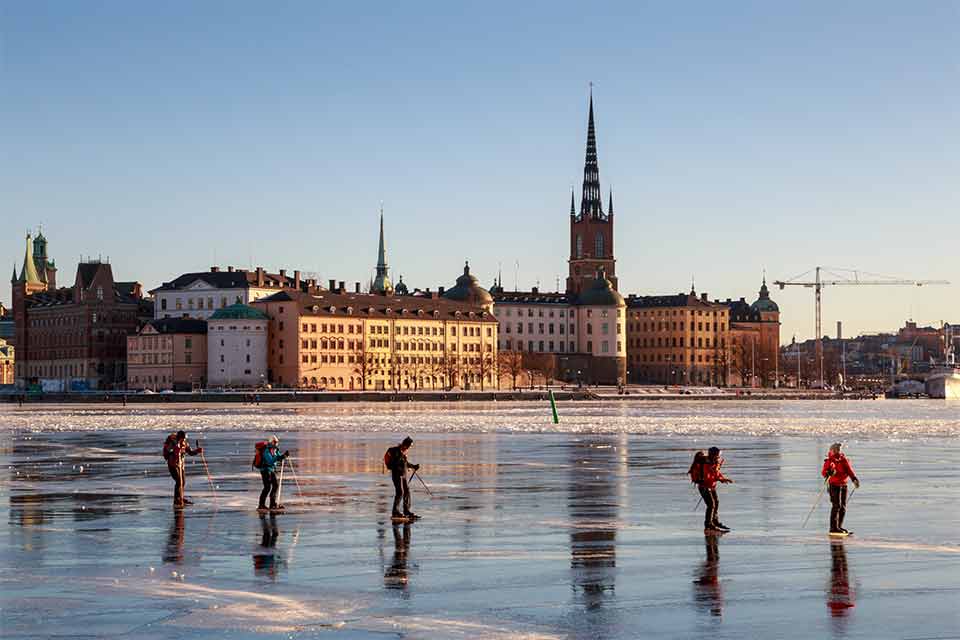
Skaters on Riddarfjärden bay, Stockholm, photo by Roland / Stock.adobe.com
Autumn is höst, a wholly appropriate word, as curt and impulsive as a cough.
There are no bad smells in Stockholm, and neither are there cockroaches. I have only come across the insect in the country twice. On the first occasion I learned its name: kackerlacka. I saw it at an event dedicated to Clarice Lispector, when an actress read out fragments of The Passion According to G. H. translated into Swedish. The second sighting occurred in an aquarium at Hagaparken, in front of the shark tank. The building is heated because it has a butterfly hatchery and tropical plants, and so the temperature is never allowed to get below 90℉. The contrast with the outside air is lovely, especially if you visit on a winter’s day when the surrounding park is covered in snow. There, next to the glass tank, in the dark hall lit only by lights in the water, I saw a cockroach for the first and only time in Stockholm. Large and coppery like the best specimens you find in Buenos Aires, this foreigner had made itself at home in the only warm, dark place in the city.
Autumn is höst, a wholly appropriate word, as curt and impulsive as a cough. In autumn, like everywhere else, people get sick and their allergies act up, not because of the cold but rather the necessity of spending time in small, enclosed spaces with other people. The winter is so long and dark it’s known as the “winter half of the year”: vinterhalvåret. Like other places where the cold is very intense, in Stockholm there are lots of different kinds of snow. But there’s one kind of snow that has only been named in Swedish: nysnö, new snow. New snow is volatile, fresh, and spongy. When it first touches the skin it feels very pleasant, like stroking a poodle or white sheep, but that only lasts for a moment before the pain strikes. Treading on nysnö is like treading on noise-cancelling foam. Old snow, which doesn’t have a name, is compact and lumpy. When you tread on it, it makes a rubbery sound. When it’s very cold and the air is completely dry, there’s a kind of snow that glows at night. The flakes are like tiny diamonds and continue to sparkle for several minutes in your hair or on people’s gloves.
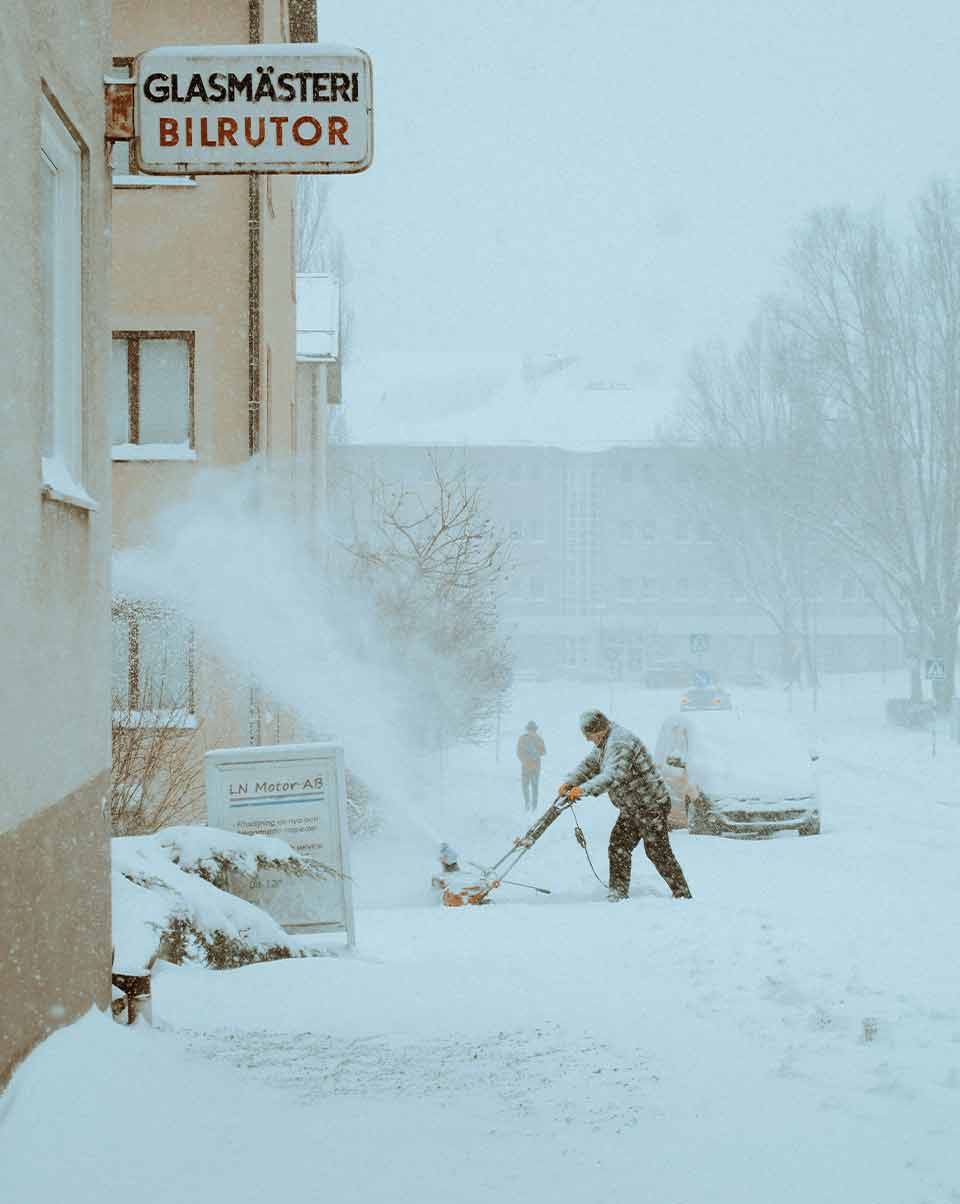
But there’s one kind of snow that has only been named in Swedish: nysnö, new snow.
If the temperature rises in winter and rain falls instead of snow, the city becomes one big hazard. The water freezes at night and in the morning the streets are shiny and slippery as ice rinks. It can take you twenty minutes to walk a couple of blocks. The old people know this, which is why they’ve disappeared.
During the cold, dark months, Swedes prefer shadowy rooms and glowing fires. Indoors, the light always comes from below, from multiple candles and lamps placed on a table or a windowsill. They don’t like lighting from above or harsh light, perhaps because their sun is never right above you and doesn’t glare.
In winter, they continue to exercise, run, take Latin dance classes, and go to the gym. Even on the coldest days, when it’s ten or fifteen degrees below zero, you’ll see pairs of runners in tight clothing and expensive, substantial sneakers trotting through forests and parks, clouds of condensation billowing from their mouths. Spartan in temperament, they tend to their bodies with a willpower that can be quite bewildering to foreigners. Many of them resist the natural winter urge to stay indoors, eat hot food, and forget about one’s body under layers of comfortable clothing. They rebel and force themselves to go outside. They wake up at five in the morning on the coldest days of the year. They have a special word to describe this rejection of snowbound sedentarism: rörelseglädje, which means “the joy of movement.” They put it into practice through salsa classes or taking long walks in the snow with their dogs. The dogs are as quiet as their owners. They travel on public transport and never bark, or when they do, people turn to look. The word for silent is tyst, which sounds like a hiss and, in my opinion, should always be pronounced with a finger to the lips.
Between winter, vinter, and spring, vår, there is an unofficial intermediary season: vårvinter. It’s a moment of transition when the snow melts and the whole city turns into a quagmire. The “March waters” here are from ice melt. When people praise snow, they always seem to forget this dirty version, the color and consistency of wet sand, which stains your shoes and makes walking a chore. During vårvinter, children cast off the padded onesies that kept them warm during winter, run around and jump for joy, a joy they can’t explain—which might possibly be related to the rediscovery of the contours of their actual body, which have been buried for months underneath layers and layers of clothing. Swedes dress their children according to a principle they call lager på lager, which means layer upon layer. It’s not rocket science, but they’re very proud of it and firm on the specific materials each layer should consist of. They must have developed said principles over centuries of having to dress children for cold weather. All their clothing for children is colorful and cheery, quite different from clothing for adults, which is generally restricted to gray, black, or blue. As they grow older, Swedes shed their color.
During vårvinter, adults who drink coffee in candlelight in winter are surprised and pleased to find that the day has won back an hour from the night, and compare the weak light of a December afternoon with the new light of March.
March 25 is Crane Day. It’s traditionally celebrated in the south, where said birds appear in the sky again after the long winter months. A popular saying has it that cranes bring light to the bed (“Tranan bär ljus i säng”); the arrival of the cranes means that the darkness is receding and you don’t have to light a candle to go to bed.
At some point in April, weather forecasters on television celebrate a small ritual. If, throughout the previous week, nowhere in Sweden has experienced below-zero temperatures, it’s time to officially declare the arrival of spring: Våren är här! Våren är här! The gloves disappear and ankles become visible once more. Romanians return to play their accordions on Drottninggatan, the pedestrian street in the city center, which also fills with other musicians and Thai evangelists brandishing Bibles. This all occurs at the first hint of spring, which is defined by the light alone, before the first daffodil has flowered or buds have appeared on the trees in Humlegården.
Spring comes around every year, but its arrival is never banal. Life has two very clearly defined periods: the months of light and the months of darkness. And to survive it, you must forget. Swedes train their memory to adopt a kind a seasonal amnesia. The first rays of sun that feel truly warming, that redden your skin just a touch, are elixir enough to banish the memory of winter until the next year like a handful of nysnö.
Translation from the Spanish

